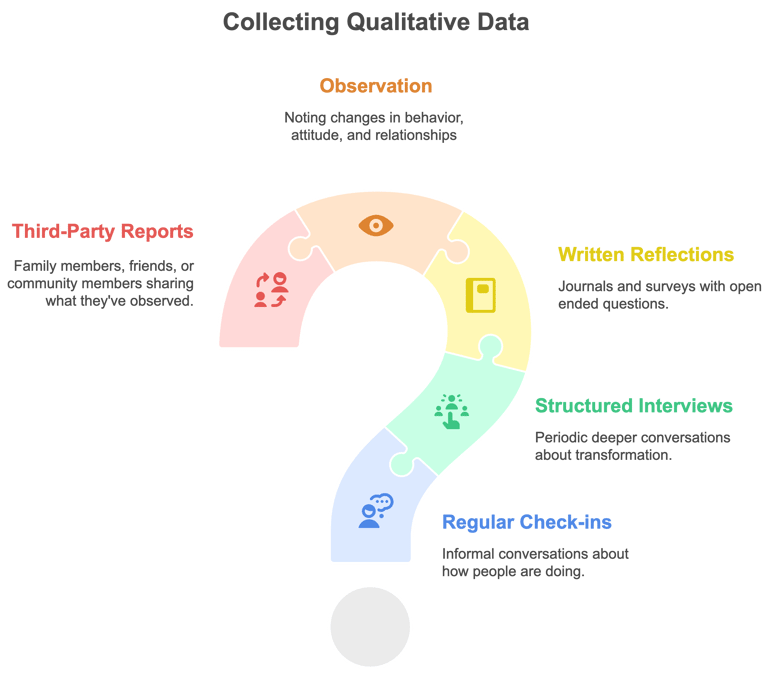9. Creating a Theory of Change Step 5: Measuring Success
Brandon Booth
7/28/20256 min read
Never miss a post! Signup for my email updates today and get expert guidance delivered directly to your inbox!
Last week we tackled Step 4: identifying outcomes that link your strategies to your goals using "so-that" thinking. Now you have a clear pathway from your activities to your ultimate goal, but you're probably wondering: "How do I know if it's actually working? How do I measure heart transformation?"
Today we'll tackle Step 5: how to measure success in ways that actually reflect the heart transformation you're seeking.
What you measure is what you value—and if your mission is about heart change, your measurements need to reflect that. This might challenge how you've thought about measurement before, but it's essential for knowing whether your ministry is truly effective.
Let's start with why traditional metrics often miss the point in ministry.
The Problem with Traditional Ministry Metrics
What Many Ministries Measure:
Attendance numbers: How many people came to programs. This is usually the first question asked after any ministry event.
Activity completion: How many programs were run, meals served, counseling sessions conducted. These outputs show you've been busy.
Financial metrics: Budget size, donations received, cost per person served. These numbers matter for sustainability but don't show impact.
Participation rates: How many people completed programs or attended events. Again, this shows engagement but not transformation.
Why These Metrics Fall Short:
They measure outputs, not outcomes: You know what you did, but not what changed. You can tell people how many came to your program, but you can't tell them if lives were transformed.
They don't capture heart transformation: A person can attend every program and still have an unchanged heart. Perfect attendance doesn't equal spiritual growth.
They incentivize the wrong behaviors: Focus shifts to filling seats rather than changing lives. You start optimizing for numbers instead of transformation.
They miss the real story: The most important transformations often happen in unmeasurable moments—a quiet conversation, a moment of realization, a gradual shift in perspective.
The Danger of Misaligned Measurement:
What you measure becomes your focus: If you only count attendance, you'll optimize for attendance. Your strategies will shift toward getting more people in the door rather than transforming the people who are already there.
Funders and supporters get confused: They think bigger numbers always mean greater impact. A ministry serving 100 people with shallow impact looks more successful than one serving 20 people with deep transformation.
You lose sight of your actual mission: The means (programs) become the end instead of the transformation you're seeking. Running programs becomes the goal rather than changing lives.
Example: A food pantry that measures success by meals served might miss whether families are experiencing dignity and God's love. They could be efficiently distributing food while completely missing their heart-change mission.
The Power of Qualitative Measurement
What Is Qualitative Measurement?
Definition: Measuring the quality and depth of change, not just the quantity. It's about understanding the meaning and significance of transformation, not just counting it.
Focus on stories: Individual narratives of transformation that show how lives have actually changed. These stories reveal the real impact of your ministry.
Emphasis on meaning: What changes mean to the people experiencing them. How do they interpret and understand their own transformation?
Recognition of complexity: Acknowledging that transformation is messy and non-linear. People don't change in straight lines—they have setbacks, breakthroughs, and seasons of slow growth.
Why Qualitative Measurement Matters for Ministries:
Heart change is inherently qualitative: You can't reduce someone's encounter with God to a number. The most important transformations—experiencing God's love, finding hope, developing secure identity—are qualitative by nature.
Stories reveal true impact: A single story of transformation can show more impact than 100 attendance records. One person's journey from despair to hope tells you more about your effectiveness than any spreadsheet.
It aligns with your mission: If your goal is heart transformation, your measurement should reflect that. Measuring what you actually care about keeps you focused on your true purpose.
Examples of Qualitative Measures:
Recovery Ministry:
Stories of transformation: "John went from hiding his addiction to openly sharing his struggles and helping others"
Evidence of heart change: "Sarah talks about feeling God's love for the first time and how it's changing her relationship with her children"
Community impact: "Families report feeling hope again and seeing their loved ones as people, not just addicts"
Youth Ministry:
Identity development: "Maria went from believing she was worthless to confidently sharing how God delights in her"
Relationship changes: "Parents report their teenagers are more open and respectful at home"
Leadership emergence: "Three former participants are now mentoring younger teens"
Marriage Ministry:
Renewed intimacy: "Couples describe feeling like they're falling in love again"
Conflict resolution: "Partners report being able to fight fair and resolve issues without attacking each other"
Spiritual growth: "Marriages become a source of experiencing God's love rather than stress"
How to Collect Qualitative Data:
Regular check-ins: Informal conversations and observations about how people are doing. These don't have to be formal interviews—just genuine interest in people's lives.
Structured interviews and surveys: Periodic deeper conversations about transformation. Set aside time to really listen to people's stories.
Third-party reports: Family members, friends, or community members sharing what they've observed. Others often notice changes that the person themselves might not recognize.


Making Qualitative Data Credible:
Look for patterns and track changes: Multiple stories pointing to similar types of transformation. When you hear the same themes repeatedly, you know you're seeing real impact. Document progression, not just snapshots. Show how people move through your "so-that" chains over months and years.
Use multiple sources: Don't rely on just one person's perspective. Get input from participants, family members, staff, and community members.
Be honest about setbacks: Include the full story, including struggles and failures. Real transformation includes setbacks, and honest measurement acknowledges this.
Balancing Qualitative and Quantitative Measures
You Still Need Some Numbers:
Accountability to supporters: Donors and boards often need quantitative data to understand scope and stewardship. They want to know their investment is being used well.
Tracking reach: Numbers help you understand the scope of your impact. How many people are you serving? How has that changed over time? Are you reaching more people? Are retention rates improving?
Resource planning: You need to know how many people you're serving for budgeting and staffing decisions. Numbers inform practical decisions.
The Right Balance for Ministry:
Lead with qualitative: Stories and transformation should be your primary focus. When someone asks about your impact, start with stories, not statistics.
Support with quantitative: Use numbers to provide context and credibility. Numbers can make your stories more compelling and help people understand scale.
Connect the two: Show how your numbers relate to your stories. Don't let them exist in separate worlds.
Example: "We served 50 families this year (quantitative), and here are three stories that show how lives were transformed (qualitative). These stories represent the kind of change we're seeing across all the families we serve."
Common Mistakes to Avoid:
Over-measuring: Don't try to measure everything—focus on what matters most. Too much measurement becomes burdensome and ineffective.
Under-documenting: Don't assume you'll remember the stories—write them down. Great stories get lost if you don't capture them systematically.
Ignoring negative data: Include setbacks and failures in your measurement. This keeps you honest and helps you learn.
Making it burdensome: Keep measurement simple enough that it actually gets done. Complex systems often get abandoned.
Your Next Step
Exercise 1: Identify Your Key Qualitative Measures
Review your goal from Step 1 and your outcomes from Step 4
Ask: "What would transformation look like in the lives of the people we serve?"
Choose 2-3 specific qualitative measures that would show this transformation
Exercise 2: Design Simple Collection Methods
For each qualitative measure, identify how you'll collect this information
Keep it simple—what's the easiest way to gather these stories and observations?
Build collection into existing activities rather than creating new requirements
Exercise 3: Create Your Story Template
Develop a simple template for capturing transformation stories
Include: What was the person's situation before? What happened? How are they different now?
Make it easy for staff and volunteers to use
Conclusion
Over these nine articles, I’ve shown you how to build a complete framework for creating ministry that actually changes lives. We started with the theological foundation—understanding how hearts really change—and worked through each practical step of developing your Theory of Change.
But you don't have to figure this out alone! I'd love to help you apply these principles to your specific situation. Schedule a free 30-minute conversation with me, and let's work together to create a Theory of Change that will guide your ministry toward the transformation you're called to create.
-------------------
This concludes our series "A Theory of Change: Building a Ministry that Actually Changes Lives!" ← See the previous article, and thank you for joining me on this journey. Now go build something that changes hearts!


Let's build!
Connect with me today and let's start building your ministry that will change lives!
© Brandon Booth, 2025
Expert guidance for nonprofits and ministries.
Brandon Booth



